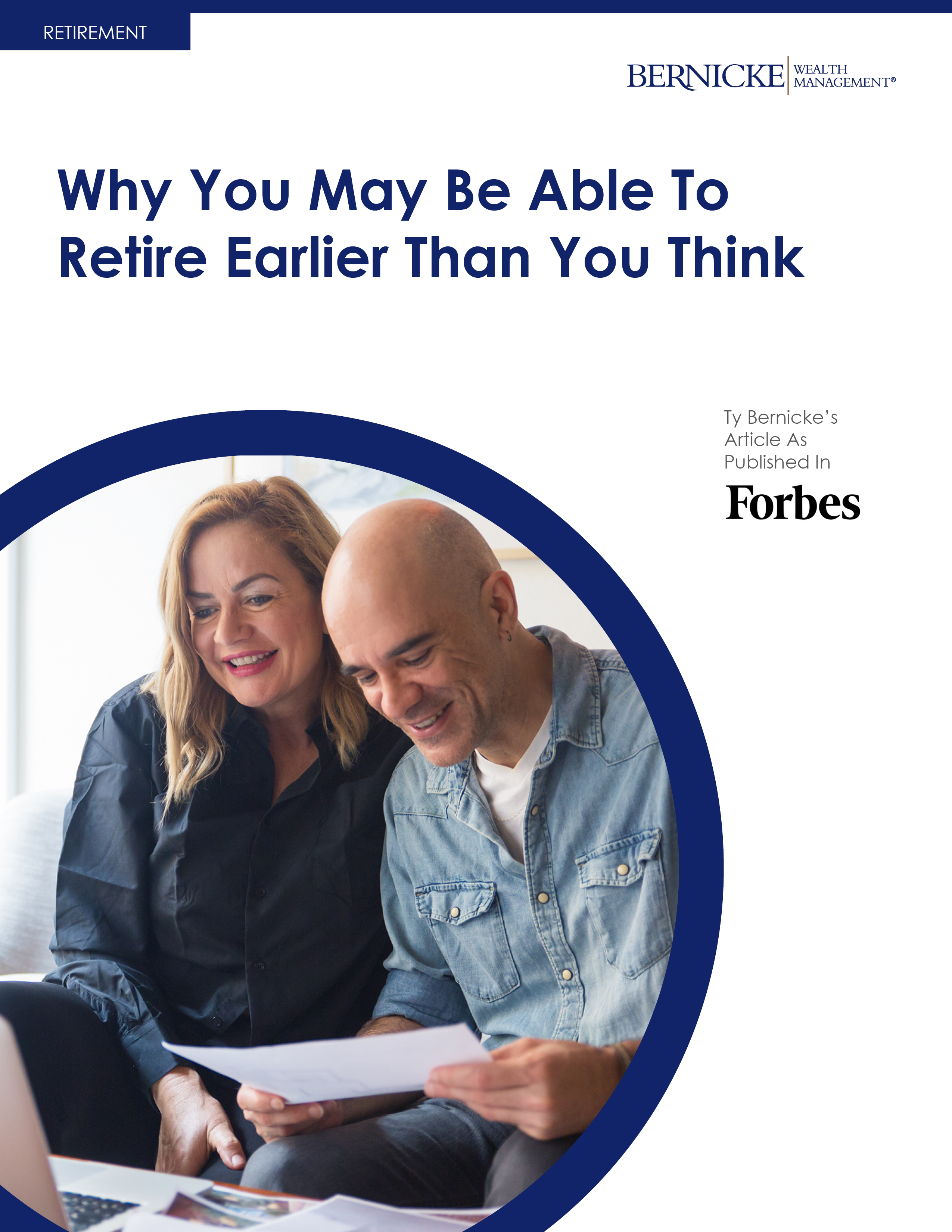What are the most common tax mistakes retirees make that could cost them tens of thousands or more in unnecessary taxes?
In this video, I uncover these critical errors and share potential strategies to avoid them, protecting your retirement savings from costly tax pitfalls.
Full transcript with subheadings:
One of the biggest tax mistakes I see retirees make is placing the wrong investments in the wrong investment buckets. So today, we’re going to talk about the tax mistakes most retirees make and how to avoid them in 2025 and beyond.
My name is Ty Bernicke, and I’ll be your speaker for today. What we’ll be covering first is building foundational knowledge that will help you understand how to implement two tax minimization strategies. I’ll also be giving you some actionable takeaways.
Building Foundational Knowledge
To start building our foundational knowledge, let’s take a look at two of the popular tax buckets people use for retirement investing: the tax deferred bucket and the tax free bucket.
Tax Deferred Bucket
The tax deferred bucket can include things like IRAs, 401(k) plans, 403(b) plans, and 457 deferred compensation plans. Most of you won’t have all of these available, but many will have one or a few. From a tax perspective, they work similarly in that when you put money into this bucket, it goes in on either a pretax or tax deductible basis. So you get a tax benefit, a tax savings right up front in the year you place money into the bucket.
Now, as the money grows in these tax deferred accounts, you don’t pay taxes on the interest income, dividends, or capital gains you might be realizing. However, when you take money out of the tax deferred accounts in retirement, the money comes out and is generally fully subject to taxation in the year you take the distributions.
Tax Free Bucket
When you contrast that to the tax free bucket, which would include things like Roth IRAs, Roth 401(k)s, Roth 457(b)s, and Roth 403(b) plans, money goes into this bucket after tax. You generally don’t get a tax break up front. However, the money grows tax free, and when you take qualified distributions in retirement, the money also comes out tax free.
The Impact of Investment Placement
When you’re looking at these two different buckets, I’ll use a very simple example to illustrate how impactful it is to think about what types of investments you should place in those buckets.
Let’s say we have somebody with a $2 million portfolio who wants to have, based on their risk tolerance, 50% in stocks and 50% in bonds. Stocks tend to make more than bonds over the long term, although not always. Stocks are not dependable over short periods, but for this example, let’s assume stocks make 9% per year and bonds make 4% per year. We’ll use a 10-year time horizon for simplicity, although many retirees can expect to live 30 years or more.
So this person has $1 million invested in an IRA and $1 million invested in a Roth IRA. Based on their risk tolerance, they put 50% of their IRA in stocks and 50% in bonds. Over ten years, that $1 million, with 9% growth on stocks and 4% on bonds, grows to a little over $1.9 million. The Roth IRA is invested the same way, so it also grows to a little over $1.9 million. The total of the two buckets after ten years is a little over $3.8 million.
Now let’s look at a second example: still $1 million in the IRA and $1 million in the Roth IRA, but this time 100% of the bonds are in the IRA, and 100% of the stocks are in the Roth IRA. They still maintain the same overall 50/50 allocation but repositioned. The total amount at the end of the time horizon is the same, but the IRA has a little less than $1.5 million, and the Roth IRA has a little over $2.3 million.
That’s close to $400,000 more in the Roth IRA (tax free), and that much less in the IRA, which will be taxed. We just repositioned where stocks and bonds are owned to minimize the highly taxed investments and maximize the tax free assets over a ten-year time frame. This strategy amplifies tax free assets and minimizes assets subject to full taxation simply by repositioning stocks and bonds.
Understanding the Non-Qualified Bucket
Next, we need to understand the non-qualified bucket of money, which is anything outside an IRA or 401(k), and outside a Roth IRA or Roth 401(k). The investments you own in the non-qualified bucket dictate the types of taxes you’ll pay.
For example, municipal bonds pay interest income that is generally tax free annually, but municipal bonds aren’t always a slam dunk because they can increase health insurance costs before Medicare eligibility, especially on ACA plans. They also can cause alternative minimum tax issues. Plus, their interest rates usually aren’t as attractive as government or corporate bonds of similar risk. If you can earn higher interest rates on those bonds held in other buckets where you don’t pay annual taxes, it can make sense to do so. Municipal bonds are not suitable for everyone; they can make sense for some investors but not for others.
Stocks and Capital Gains
If you own stocks in this market, you don’t pay tax on appreciation until you sell. Long-term capital gains (from assets held over 12 months) are generally taxed at favorable rates, lower than ordinary income tax rates. Qualified dividends are also taxed at favorable rates compared to interest income from CDs, bank accounts, corporate, or government bonds.
Bonds and Bank Accounts
If you own bank accounts or corporate/government bonds in the non-qualified bucket, you pay ordinary income tax on the interest earned each year, making them less tax efficient.
Ranking Investments by Tax Efficiency
If you were to rank investments in the non-qualified bucket from most tax efficient to least, municipal bonds can be at the top but are not ideal for everyone. Individual stocks, when managed tax efficiently, rank highly, as do index funds and ETFs, which tend to be more tax efficient than mutual funds.
Actively managed stock mutual funds vary widely in tax efficiency; some are very efficient, some very inefficient. Morningstar provides a tax cost ratio, showing how much tax drag mutual funds impose annually. For instance, a fund with a tax cost ratio of 1% means if it earned 10%, you keep about 9% after taxes.
To illustrate, a $500,000 investment with a 1.5% tax cost ratio growing at 8% annually over 30 years would grow to about $3.1 million. If the tax cost ratio is half, 0.75%, the portfolio would grow to about $3.8 million — a difference of $700,000. Small differences in tax cost ratios can add up significantly over retirement.
Why These Strategies Matter
Between organizing investments in your non-qualified bucket and placing the right investments in tax deferred and tax free buckets, these two strategies could mean hundreds of thousands of dollars extra in retirement.
How We Can Help
If you’d like to talk to one of our Certified Financial Planners, we offer virtual meetings nationwide. You can schedule by clicking the link provided or visiting BernickeWkyc.com. Our planners are educational and non-sales oriented. It’s a great way to review your situation and ensure you’re on the right path. Each year you delay these conversations means lost tax opportunities.
We’d love to talk to you again. My name is Ty Bernicke. The firm is Bernicke Wealth Management. I hope you gained some good ideas on organizing your investments for greater tax efficiency during retirement. Thank you.
Content in this material is for general information only and not intended to provide specific advice or recommendations for any individual. All investing involves risk including loss of principal. No strategy assures success or protects against loss.
Individuals showing a CFP® designation hold an active CERTIFIED FINANCIAL PLANNER™ certification. To earn the CFP® designation, the individual had to complete an approved educational program, pass a rigorous examination and meet stringent experience requirements. Designation holders also adhere to a professional Code of Ethics and fulfill annual continuing education requirements to remain aware of current planning strategies and financial trends. You can find more information about this designation at CERTIFIED FINANCIAL PLANNER™ (CFP®) Certification.



